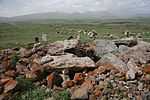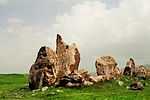Zorats Karer
| Carahunge Քարահունջ | |
|---|---|
 | |
 Shown within Armenia | |
| Alternate name | Zorats Karer, Carenish, Dik-dik karer |
| Location | near Sisian, Syunik Province, Armenia |
| Coordinates | 39°33′2.52″N 46°1′42.96″E / 39.5507000°N 46.0286000°ECoordinates: 39°33′2.52″N 46°1′42.96″E / 39.5507000°N 46.0286000°E |
| Type | possibly a necropolis or observatory |
| History | |
| Founded | construction date unknown |
| Periods | Middle Bronze Age to Iron Age |
| Site notes | |
| Condition | Is being protected by the government and is in good condition |
| Website | carahunge.com |
Zorats Karer (Armenian: Զորաց Քարեր, locally Դիք-դիք քարեր Dik-dik karer),[1] also called Karahunj, Qarahunj or Carahunge and Carenish (Armenian: Քարահունջ և Քարենիշ) is a prehistoric archaeological site near the town of Sisian in the Syunik Province of Armenia. The phrase Zorats Karer is literally translated from Armenian as Army Stones. It is also often referred to in international tourist lore as the 'Armenian Stonehenge.'[2]
Location
The Carahunge site is on latitude of 39° 34' and longitude of 46° 01' on the mountain plateau having altitude 1770 m and occupies a territory of about 7 hectare on the left side of the Dar river canyon, the tributary of the river Vorotan (at 2 km). It is located on a rocky promontory near Sisian.[3]
Name
Armenian historian Stepanos Orbelian in his book 'History of Syunic' (I-XII centuries) mentioned that in Tsluk (Yevalakh) region of Armenia, near town Syunic or Sisian was a village Carunge,[4] which means in Armenian Stone Treasure or Foundational Stones.
The name Carahunge is interpreted as deriving from two Armenian words: car (or kar) (Armenian: քար), meaning stone, and hunge or hoonch (Armenian: հունչ), meaning sound. Thus the name Carahunge means Speaking Stones.
This interpretation is related to the fact that the stones make whistling sounds on a windy day, presumably because of multiple reach-through holes bored under different angles into the stones in prehistoric times.
In 2004, the site was officially named the Karahunj (Carahunge) Observatory, by Parliamentary decree (Government decision No. 1095-n, July 29, 2004).
Carahunge is also known in local lore as Zorats Karer (Զորաց Քարեր), Dik-dik Karer (Դիք-դիք քարեր), and Tsits Karer (Ցից Քարեր), meaning Vertical Stones in vernacular Armenian.
Stones

The Carahunge Monument consists of the following parts: the central circle, the north arm, the south arm, N-E alley, the chord (crossing the circle) and separate standing stones.
The site is rich with stone settings, burial cysts and standing stones - Menhirs. In total registered 223 stones.[5]
The heights of the stones range from 0.5 to 3 m (above ground) and weight up to 10 tons. They are basalt (andesit) stones, eroded by time and covered with moss and lichen of many colours. The inside surface of holes preserved much better. There are also many broken and unnumbered stones.
About 80 of the stones feature a circular hole, although only 37 of the stones, with 47 holes, are still standing. They have been of interest to Russian and Armenian archaeoastronomers who have suggested that the standing stones could have been used for astronomical observation. Seventeen of the stones were associated with observations of sunrise or sunset at the solstices and equinoxes, and 14 with the lunar extremes.[6] However, this must remain conjectural as the holes are relatively unweathered and may not even be prehistoric in origin.[7]
Investigations
Investigation by radiophysicist Paris Herouni and his research team during 1994-2001 concluded that Carahunge is the world's oldest astronomical observatory.[8]
Zorats Karer was investigated in 2000 by archaeologists from the Institut für Vorderasiatische Archäologie, University of Munich, as part of a field survey of prehistoric sites in southern Armenia. They identified the site as a necropolis dating mainly from the Middle Bronze Age to the Iron Age, finding enormous stone tombs from those periods within the area. Team leader Stephan Kroll also concluded that the lines of stones were actually the remains of a city wall, possibly from the Hellenistic-period, that had been constructed mostly of rubble and loam, and in which the upright stones had acted as reinforcements.[9][10]
Archaeoastronomer Clive Ruggles wrote that 'Inevitably there have been other claims—more speculative and less supportable—relating to the astronomical significance of the site. One is that it can be astronomically dated to the sixth millennium BCE and direct comparisons with Stonehenge, which few now believe was an observatory, are less than helpful.'[7]
A recent critical assessment found several problems with the archaeoastronomical interpretations of the site. The northeast avenue, which extends about 50 meters from the center, has been inconsistently associated with the summer solstice, the major northern lunistice, or the rising of Venus.[6] Harouni had postulated that in order to use the holes in the megaliths for astronomical observations sufficiently precise to determine the date of the solstices, it would have been necessary to restrict the field of vision by inserting a narrow tube in the existing perforations. Without these modifications, for which there is no archaeological evidence, the claimed astronomical significance of the orientations of the holes vanishes. As a consequence, González-Garcia concluded that the archaeoastronomical claims for the site are untenable, although further investigations to determine the astronomical potential of Carahunge and similar sites are merited.[11]
Museum
In the nearby city of Sisian, there is a small museum dedicated to findings in the area, including palaeolithic petroglyphs found on mountain tops in the area, and grave artefacts form the Bronze Age burial site with over 200 shaft graves.
Gallery
-

One of the stones with a hole in it
-
Stones row
-

Interior part
-

Circular stones row
-

-

-

-

-

-

-

-
Karahunj (Zorats Karer)
-
Karahunj (Zorats Karer)
-
Karahunj (Zorats Karer)
-
Karahunj (Zorats Karer)
-
Karahunj (Zorats Karer)
See also
References
- Notes
- ↑ Քարահունջի չտեսնված հմայքը. 1in.am (in Armenian). 3 July 2013. Retrieved 14 November 2013.
- ↑ "The Vorotan Project". Kelsey Museum of Archaeology. 2005. Retrieved 9 November 2013.
- ↑ Herouni, Paris (2004). Armenians and Old Armenia. Yerevan, Armenia: Tigran Mets.
- ↑ Orbelian, Stepanos (1986). History of Syunic (I - XII centuries). Yerevan. p. 395.
- ↑ "Karahunj (Zorats Karer)". Wondermondo.
- ↑ 6.0 6.1 González-Garcia, A. César (2014), "Carahunge - A Critical Assessment", in Ruggles, Clive L. N., Handbook of Archaeoastronomy and Ethnoastronomy, New York: Springer Science+Business Media, p. 1455, doi:10.1007/978-1-4614-6141-8_140, ISBN 978-1-4614-6140-1
- ↑ 7.0 7.1 Ruggles, Clive (2005), "Carahunge", Ancient Astronomy: An Encyclopedia of Cosmologies and Myth, Santa Barbara, CA: ABC CLIO, pp. 65–67, ISBN 1-85109-477-6
- ↑ Paris Herouni, Armenians and Old Armenia, Yerevan, 2004.
- ↑ "2000 Survey in Southern Armenia".
- ↑ "2000 Survey in Southern Armenia". Archived from the original on 2007-12-23.
- ↑ González-Garcia, A. César (2014), "Carahunge - A Critical Assessment", in Ruggles, Clive L. N., Handbook of Archaeoastronomy and Ethnoastronomy, New York: Springer Science+Business Media, pp. 1453–1460, doi:10.1007/978-1-4614-6141-8_140, ISBN 978-1-4614-6140-1
- Bibliography
- Herouni, Paris (2004). Armenians and Old Armenia. Yerevan, Armenia: Tigran Mets.
- Ruggles, Clive (2005). Ancient Astronomy. ABC CLIO. ISBN 1-85109-477-6.
External links
| Wikimedia Commons has media related to Zorats Karer. |






